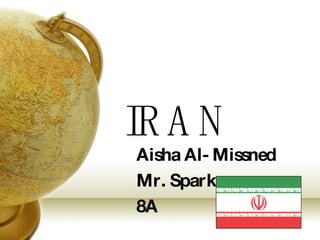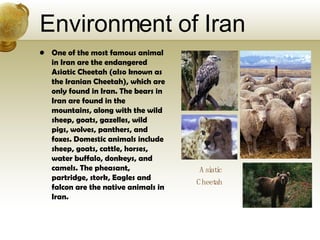Iran
- 1. IRAN Aisha Al- Missned Mr. Sparks 8A
- 2. Where Iran is located? Iran is located in Southwest Asia. Iran is nearby the Gulf of Oman, the Persian Gulf, and the Caspian Sea (the blue area in map) between Iraq and Pakistan
- 3. Geographic Features of Iran Iran is one of the world's most mountainous countries. Alborz Mountains: The Alborz Mountains stretch along the northern border of Iran and the Caspian Sea, with Tehran nestling on their southern central slopes. Mount Damavand is the highest peak in the Alborz Mountains and Iran (Damavand, 5604 metres). Zagros mountains: The Zagros Mountains have many peaks higher than 3000 m, some of them have continuous snow cover. The highest peak in all the Zagros mountain is Zard K┼½h with 4,547 m. The Alborz Mountains ┬Ā ┬Ā┬Ā┬Ā┬Ā┬Ā┬Ā┬Ā┬Ā┬Ā┬Ā┬Ā┬Ā┬Ā┬Ā┬Ā┬Ā┬Ā┬Ā┬Ā┬Ā┬Ā┬Ā
- 4. Climate of Iran Iran has a hot, dry climate because of the long, hot, dry summers and short, cool winters. The climate is controlled by IranŌĆÖs location between the dryness of the Arabian desert areas and the dampness of the eastern Mediterranean area. January is the coldest month, with temperatures from 5┬░C to 10┬░C. August is the hottest month with a temperature of 20┬░C to 30┬░C or more. In the summer it can be both cool and warm. In winter the weather is cold with heavy snowfall during the months of December and January.
- 5. Environment of Iran One of the most famous animal in Iran are the endangered Asiatic Cheetah (also known as the Iranian Cheetah), which are only found in Iran. The bears in Iran are found in the mountains, along with the wild sheep, goats, gazelles, wild pigs, wolves, panthers, and foxes. Domestic animals include sheep, goats, cattle, horses, water buffalo, donkeys, and camels. The pheasant, partridge, stork, Eagles and falcon are the native animals in Iran. Asiatic Cheetah
- 6. History of Iran A major earthquake occurred in the South- East of Iran, killing 40,000 people. Mohammad Khatami wins the presidential election with 70% of the vote. There was a long vicious War between Iran and Iraq. The ShahŌĆÖs son took control. He was an ally of USA and Britain. The ShahŌĆÖs son was overthrown. Iranian military officer took power. He claimed the Persian the title of Shah (king.) Arabs invaded the region and established Islam. Alexander the Great conquered the Persian Empire. The Persian Empire was established in Iran. 2003 1997 1980-1988 1941 -1979 1921 600s A.D 300s B.C 500s B.C Event 8 Event 7 Event 6 Event 5 Event 4 Event 3 Event 2 Event 1
- 7. Customs and Traditions Sizdah-bedar is an Iranian festival tradition, celebrated in the thirteenth day of the Nauruz (the Persian New Year.) Iranians spend the day outdoors on the 13th day of month Farvardin. From the ancient times, Iranian peoples have enjoyed this day, although it is also the day that marks the end of the Norouz celebrations. On February the 11 th , the anniversary of the Iranian Revolution is celebrated. The first 12 days of the year are very important, because they symbolize order in the world and in the lives of people. The 13th day marks the beginning to return to ordinary daily life. Men should wear business dress, particularly in meetings. Short-sleeved shirts are acceptable in the summer, however if Ramadan or any other holy day fall during the summer, men are to wear respectable clothes. Women clothes require to wear a loose coat that reaches below the knee, the legs must be covered by pants or stockings. The hair and neck is to be covered by a scarf. Despite the clothes rule, women in Iran can do whatever a men can do. They can go out alone, drive, work outside home. However men and women are forbidden to shake hands or have any physical contact with each other in public. The Sizdah-bedar festival WomenŌĆÖs clothing
- 8. Government of Iran IranŌĆÖs government type is theocratic republic which means a government ruled by religious leaders. The highest authority in the Islamic Republic is the Leader. His job is to combined the best political and religious power. Iran has an elected president and parliament. However an expert on Islamic laws is the best leader. The second highest authority next to the leader, is the president. The President signs and supervises the accomplishment of laws approved by the Majles (an Arabic world for parliament). The President receives the recommendation of foreign ambassadors. His responsibilities also include the management of the country's budget and development plans confirmed by the Majles. Iran is a hard-line policies (firm and uncompromising ). For example the government called for destruction of the state of Israel. IranŌĆÖs current leader Mahmoud Ahmadinejad
- 9. Economy of Iran The economy of Iran is a transition economy which means an economy which is changing from a centrally planned economy to a free market economy. Iran is one of the countries that receives the most oil. Oil is the main industry. Other industries include construction, food processing, and the production of beautiful woven carpets. Iran is a member of the OPEC (organization of petroleum exporting countries.) One third of IranŌĆÖs employees is employed in agriculture.
- 10. Tourism in Iran One of the oldest and most popular villages in Iran is the Kandovan village . The Kandovan village is located 22km from Osco city. Kanfovan village has a pyramid shaped houses that have a beautiful rocky architecture. Some researches show that the village has been there before the Islamic era. These houses are still being occupied. Kandovan village is a popular resort and there are hotels and restaurants there for the tourists. The mineral water in the village is believed to be a cure for kidney disease.
- 11. Global Awareness Social Classes Social class generally categorizes the society into certain group depending on their wealth (economic status), their social identity or family name whether itŌĆÖs linked with a political figure such as a leader or a president and their religion. Social class distinguishes each group and labels each person accordingly; to the Iranian itŌĆÖs a form of an inner identity amongst them, just like in the UK in the 18th century where social class was important in society. The Upper Class: The upper class is made of large landowners, industrialists, financiers, and large-scale merchants. They remained part of the upper class by staying in Iran and having maintained a significant part of their wealth. Wealth was apparently no longer a characteristic of authority A good example of an upper class is Khomeini, he was the leader of Iran. The Middle Class: The middle class is divided into two major parts; the first section is the ones who had a Western education, the second part is those who are distrustful of Western education. The middle class tended to be found among those employed in the system of government, merchants and the clergy. The Lower Class: Members of the urban lower class can be know by their low education, performance of manual labor, and generally unimportant existence. The lower class is divided into two groups: those with normal employment and those without any employment. The people with the normal work include household servants, street cleaners, office cleaners, laundry workers, and bakery workers.
- 12. Global Awareness ┬Ā Physical: The area of Iran can be divided in to four main parts. The mountains are half the area. The deserts is quarter the area, and finally the other quarter is the fertile plains. Without these fertile plains Iran would not have as much food. Also this helps to earn jobs as framers working to produce theses crops. If something happens to the physical system the people are effect and the economy is effected too. For example if the fertile plains go bad then the economy will lose money, but if it gets better then it earns money. The Physical system is very important to Iran. Economical: Economy is important to Iran because it helps the country to communicate and depended on other countries for important recourses, such as oil. Oil is a very important rescore in Iran , others countries that dose not have oil depend on Iran for it. This helps the government, because it gives them money to help the people and society. The better the economy the closer the country is to having a modern life style. To improve the economy is to have a better commutation with other countries. Also to have more natural resources to help the country to import more resources. The economy is important to Iran because without it the country will have many difficulties and problems.
- 13. Bibliography Iran ." The World Factbook. 1981 . 6 Jan 2008 <ŌĆó https://www.cia.gov/library/publications/the-world-factbook/print/ir.html >. "Iran Weather ." 2002 - 2005 . ISTA, INC. 6 Jan 2008 <http://www.irantour.org/Iran/Climate.html>. "Iran." The Politics of Groups, Classes, and Modernization. 1972 . 6 Jan 2008 <http://countrystudies.us/iran/48.htm >. BBC, "Timeline: Iran ." 6 Jan 2008 <http://news.bbc.co.uk/1/hi/world/middle_east/806268.stm>. Wikipedia, "Environmental issues in Iran." 6 Jan 2008 <http://en.wikipedia.org/wiki/Environmental_issues_in_Iran>. "Iran Weather ." 2002 - 2005 . ISTA, INC. 6 Jan 2008 <http://www.irantour.org/Iran/Climate.html>. Sager , Robert J. People, Places, and Change. United states of America : A time Warner Company, 2000. (Iran 430)












